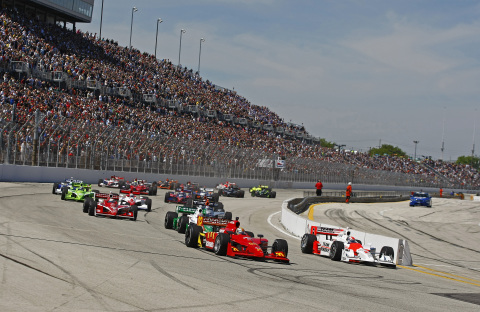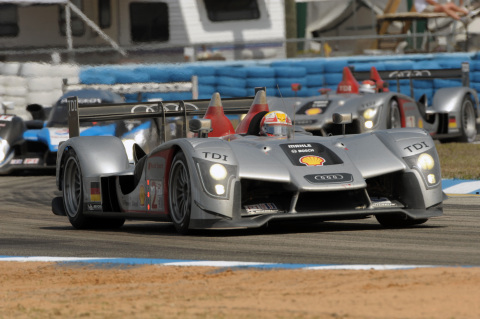The Way It Is/ It's about the spec car, stupid!
by Gordon Kirby Many of us find ourselves chuckling these days over NASCAR's hand-wringing and 'town hall' meetings discussing big-time stock car racing's declining crowds and TV ratings. For years we've watched NASCAR sell its soul and turn itself from a sport into a marketing vehicle as the price of tickets and collectibles have been driven through the roof and many hardcore fans have complained for a long time that NASCAR has lost its way.
Many of us find ourselves chuckling these days over NASCAR's hand-wringing and 'town hall' meetings discussing big-time stock car racing's declining crowds and TV ratings. For years we've watched NASCAR sell its soul and turn itself from a sport into a marketing vehicle as the price of tickets and collectibles have been driven through the roof and many hardcore fans have complained for a long time that NASCAR has lost its way.
Looking back, it's pretty clear that NASCAR lost the plot as it was transformed from decades of dictatorship under Bill France Sr. and Jr. into today's massive, greed-driven bureaucracy where salesmen and marketers are king. The mantra of these geniuses was all about moving NASCAR upmarket and finding new fans but slowly, year by year, they've succeeded in driving away many oldtime fans, overcharging them and offending them with modern marketspeak.
To many oldtime fans today's NASCAR stars are just corporate pitchmen, hardly independent souls like Fireball Roberts, Junior Johnson, Cale Yarborough and Bobby Allison, the type of men who sharply defined NASCAR for so many decades.
Of course, the world has changed over the last eight or more months. Quite a few NASCAR fans have lost their jobs or are facing serious belt-tightening so they no longer can afford the steep costs of grandstand seats, travel and hotels. But there's more to NASCAR's problems than the harsh reality of today's economic conditions.

© LAT USA
Racing of every type and kind has always been about the next new thing. It's always been about producing something that is lower, sleeker, slicker and faster with a sharper, better-sounding exhaust note. Therein lay the sport's beating heart--alive with aesthetics--but during NASCAR's boom years the organization's widening thicket of bureaucrats lost their minds to hubris and lost track of the sport's essential character. Almost unwittingly, NASCAR's creation of the CoT placed it in the vanguard of spec car racing and out of kilter with motor racing's history.
At the Daytona 24 hours earlier this year I enjoyed a conversation with Kyle Petty about the state of the sport amid today's tough economic climate. Kyle may not be the world's greatest racer but he has tremendous passion for racing and is also a well-read man who's always trying to think 'outside the box'. But what he had to say that day last January was entirely inside the box.
"I know so many oldtime race fans who were big fans of my Daddy or Cale Yarborough or Earnhardt," Kyle remarked. "They loved those guys and they loved the different cars. They were Ford guys or Chevy guys or Chrysler guys. But today so many of those folks just don't care. I hear it all the time around home. They used to be NASCAR fans, but not anymore."
I said to Kyle that I was deeply familiar with the occurrence. I told him that if he came to my little town in New Hampshire he would hear the same story. The message for NASCAR lays in the fans who have deserted them, not among the modern fans. But NASCAR seems incapable of surveying or reaching-out to those folks who've turned their backs on the sport. And too, many of those old-timers probably wouldn't talk because they hold the modern version of NASCAR in so much contempt.
In fact, it's contempt for the sport that's brought motor racing to where it is today. I well remember a day fifteen years ago when Tony George and former IMS marketing director Bill Donaldson told me that the technical content of the cars really didn't matter anymore. They could race anything at Indianapolis--even golf carts, Donaldson grinned--and the grandstands would be full.
And of course, CART employed marketing man after marketing man who knew nothing about the sport and talked down to all of us, informing us that we were too embroiled in the technical niceties of the game to understand the big picture where the cars and engines didn't matter and it was all about marketing and selling product.
Time and again, we listened to these denizens of the revolving door prattle on about how they were going to fix the sport with their big picture thinking only to read a press release a few weeks or months later saying they had departed the scene with a nice severance package to boot. They came, they saw, they failed and the sport continued to slide downhill.

© LAT USA
This breaking of the chain occurred as first USAC, then the SCCA, CART and IRL neglected and totally mismanaged the open-wheel ladder system's transition from midget and sprint car racing to Formula Atlantic and Indy Lights at the same time that NASCAR came to define American racing. Jimmy Vasser and Sam Hornish had their shots at superstardom but as Indy car racing fell into sharp decline Vasser and Hornish were unable to gain any traction in the marketplace or establish legendary identities like the great Indy car drivers of the 20th century.
Indeed, the IRL has failed comprehensively in most of its stated missions, particularly solving the riddle of developing new American talent. Today, there are just five American drivers regularly racing Indy cars--Graham Rahal, Danica Patrick, Marco Andretti, Ryan Hunter-Reay and Ed Carpenter--and all of them have a long way to go before they're acknowledged as true superstars, let alone legends.
Over the years we've heard endless wailing about finding the right marketing man or the leader with the right 'vision'--a word that has lost all meaning--to repair and rebuild the sport. But what was really required was a strong leader who had a philosophical commitment to the spirit of motor racing--a sport driven by technology, new ideas and innovation--and a deep understanding of the technical elements and dynamics of motor racing.
The blinding absence of any technical or philosophical leadership has caught up with the sport in recent years as the rulemakers have done their best to discourage innovation. Their repeated solution over the last four decades was to issue ban after ban, setting the sport on a slippery slope to today's spec car syndrome which is everywhere--NASCAR, IRL, Grand-Am, etc--and is even creeping stealthlike, but inevitably, into F1.
Is there no turning back? Is racing stuck on a track where technology and aesthetics are spurned and everyone subscribes to NASCAR's philosophy of a field full of identical, unattractive cars chasing around as close together in follow-the-leader style?

© LAT USA
But conventional wisdom also says that in today's economic climate the spec car is here to stay and looking at the ALMS--the only major series in America where the spec car has been discouraged in favor of new technology and factory participation--you can only shake your head at the implosion that's taken place this year.
Sadly, if Acura terminates its P1 and P2 programs, as expected, and Audi doesn't return at the end of this year, the ALMS is in danger of becoming even less healthy. If the ALMS falls into truly dire straights many longtime fans will find themselves even more disgruntled with the sport's stunning lack of technical and philosophical leadership.
Next weekend in France the world's most free-form motor race takes place at Le Mans. The 77th Le Mans 24 Hours is sure to be everything the ALMS dreams of being. Audi will attempt to score its ninth win in the French classic with a trio of new R15 turbo diesels. Audi's primary competition will come from the three factory Peugeot 908 turbo diesels and a fourth Peugeot run by Henri Pescarolo's team while the many Brit fans at La Sarthe will be waving their Union Jacks for Dave Richards's pair of Gulf Lola-Aston Martins.
A total of 32 LMP1 and P2 cars are entered at Le Mans this year. Also among the 55-car field are seven GT1 cars, including the pair of factory Corvette C6-Rs making their last hurrah, and sixteen more GT2 cars, including ten Ferrari F430 GTs and four Porsche GT3 RSRs.
The ACO has reduced both the turbo boost and inlet restrictor size on this year's P1 cars. Boost has been cut from 2.94 bar to 2.74 bar and the inlet size is 2 mm smaller. Running to those specs this year's V-10 Audi R15 engine makes around 600 bhp, about 50 down from last year's V-12. The ACO intends to continue to restrict the P1 cars in the coming years. The club's aim is for the P1 cars to lap at P2 speeds in 2011.
So enjoy Le Mans and let's hope the ALMS is somehow able to bounce back next year. Otherwise the time may be ripe for most of us to start spending more time at the country's many historic races!
Auto Racing ~ Gordon Kirby
Copyright 2009 ~ All Rights Reserved
Copyright 2009 ~ All Rights Reserved
Top of Page